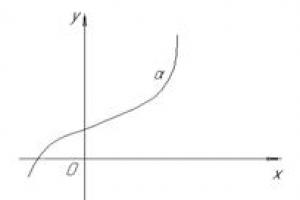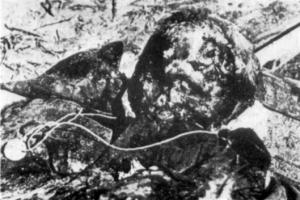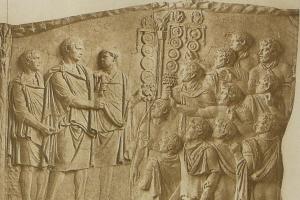On May 28, 1918, after seven centuries, the independent Armenian state was revived on part of the territories of historical Armenia. Today this day in new Armenia is considered to be Republic Day. Reasons for the formation and loss of Armenian statehood in 1918-1920. remain the subject of scientific research and expert analysis of the political processes of the early twentieth century. The lessons of the First Republic of Armenia must be clearly presented to the current generation of Armenian politicians and experts, without an objective assessment of which it is extremely difficult to expect new achievements towards strengthening the independence of Armenia in the 21st century.
The Armenian question, that is, the issue of Armenian territories and the elimination of the international legal consequences of the crime of the Armenian genocide of 1876-1923, continues to remain relevant in the regional geopolitics of the leading powers of the world in the Middle East and the South Caucasus. The historical fate of Armenia was such that its geographical location was of interest to empires that lay claim to the role of leader in such a strategically important region. Armenia has always found itself on the path of new conquerors and, unfortunately, periodically became the object of invasions, conquests, losses and destruction. The harsh political and geographical conditions of the Armenians' habitat strengthened the nation, its ancient culture and strength of spirit, the unbending will to freedom and faith in Christ became the guarantee of future revivals of the tormented people and long-suffering Armenia. The Armenian people survived despite the “objective course” of history, when everything spoke of the disappearance of this ancient and unique culture, state and nation, but time passed, and Armenia was reborn from the ashes and ruins.
Throughout its 3-thousand-year history, Armenia reached the peak of power and established itself as an empire during the reign of the “king of kings” Tigran II the Great and, in the conditions of fierce Roman-Parthian confrontation, became one of the powerful states of the Ancient World. The Armenian Empire during the time of Tigran the Great survived for virtually 30 years (85-55 BC) during the reign of one king, who continued the unification of the Armenian lands begun under Artashes and established control over the border territories - Adiabene, the Edessa and Pontic kingdoms, Atropatena, Iberia, Caucasian Albania (Agvankom), as well as Syria, Phenicia, Cilicia, Jerusalem. Greater Armenia controlled vast territories from the Caspian Sea to the eastern borders of the Mediterranean Sea, from the Greater Caucasus Mountains to the Red Sea. It was no coincidence that Tigran the Great was called the “almighty king of the East” and “the mighty enemy of Rome,” “the great among the great.” But after Tigran II, alas, Armenia was unable to maintain its control over such significant territories, and each time after successive defeats and losses, the Armenians were forced to adapt to the conditions of the conquerors or limited themselves to the liberation of their ethnic territories.
The great past of the Armenian people, combined with their conciliarity, hard work, desire for freedom and independence, has always raised the issue of reviving national statehood at all stages of the development of Armenian history before new generations. This idea has never left the best minds of the Armenian people, its political and spiritual elite. This idea was objectively combined with the role of the Armenian people in the dynamics of world economic and political relations. However, this strategy received new forms and contours where and when geopolitical conditions matured and conditions for their concentration and expression were created.
The revival of Armenian statehood at the beginning of the twentieth century, as in past times, was directly related to the geopolitical processes that were reflected in the region. In 1890, as is known, in Tiflis - the administrative center of the Russian Caucasus (obviously, not without the assistance of the Russian administration and competent services) a new Armenian political organization was created, the Armenian Revolutionary Union "Dashnaktsutyun", which was subsequently transformed into a federation - the ARF. This organization began to claim and over time turned into the main political force of the Armenian people on the path to the liberation and unification of historical Armenia.
At that time, Eastern Armenia was part of the Russian Empire, and Western and Southern Armenia were part of the Ottoman Empire.
In the context of the formation of global antagonistic blocs of the Entente and the Triple Alliance, the interests of the Armenian people were on the side of the Entente - Russia, France and Great Britain. This was explained by the fact that, firstly, in spiritually close Russia, Armenians received the most favorable conditions for national development in the fields of culture, economics, demography and administration; secondly, the Entente countries intended to carry out the division of the Ottoman Empire, which was experiencing a severe systemic imperial crisis. It cannot be said that the Armenians lived poorly in the Ottoman state, which was explained both by the enterprise and culture of the Armenians, and by the special attitude of the Turkish administration towards them. However, Sultan Abdul Hamid II at the end of the 19th century. intensified the persecution of the prosperous Armenians, considering them a direct threat to the collapse of the empire in Asia Minor, and began massacres, which marked the beginning of the tragedy of genocide. The world was heading towards a global catastrophe called “world war”. Under these conditions, the political program of Dashnaktsutyun was reduced to the liberation of Western and Southern (Cilikian) Armenia and its annexation to Russia and France, respectively.
There was no talk of any united and independent Armenia on the eve of the First World War. All the diplomatic fuss of Western countries about the formation of Armenian autonomy within Ottoman Turkey following the results of the Russian-Turkish war of 1877-1878. and, according to the decisions of the famous Berlin Congress, did not lead to the result expected for the Armenian side. On the contrary, these formal decisions of international diplomacy, not supported by a real power mechanism, only complicated the situation of the Armenians in their historical homeland and aggravated the Sultan’s mistrust of them. In fact, after the Russian-Turkish war of 1877-1878. The life of Armenians in Ottoman Turkey became a complete nightmare.
That is why the Dashnaks, on the eve of and during the First World War, did not put forward the idea of a united and independent Armenia. In the Ottoman Empire itself, the Dashnaktsutyun party at the beginning of the twentieth century. supported a new political force - the Committee of Unity and Progress. The Dashnaks hoped that the coming to power of the Young Turks would democratize Turkey, ensure the autonomous rights of the Armenian people, and that the Armenians and Turks would become state-forming nations in the new Turkey. But this policy did not lead to the expected results.
It was the Young Turks who began to implement a more brutal genocidal policy against the Armenians during the First World War. This allowed the Russian Armenians to have the opportunity to form 6 volunteer national squads in the vanguard of the Caucasian army of General Yudenich and storm Turkey in terms of liberating their compatriots, against whom the Young Turk government began massacres and deportations on April 24, 1915.
The secret agreement of the Sykes-Picot-Sazon allies in May 1916 predetermined the division of the Asian possessions of Ottoman Turkey between the allies, according to which Western Armenia was transferred to Russia, and Cilicia to France. The Turkish army was actually defeated by November 1917 by the Russian army, which by that time controlled a 500-kilometer section of territory in the direction of Trebizond-Bitlis-Van. But in October-November 1917, a revolution took place in Russia. The Council of People's Commissars of the RSFSR, headed by Lenin, having refused to participate in the world war and the previous agreements of the tsarist government, at first had one approach to the fate of Armenia, and then changed its position.
In particular, in December 1917, having signed a truce with the Turks, Lenin instructed the Extraordinary and Plenipotentiary Commissioner for Caucasian Affairs and Chairman of the Baku Council of Deputies Stepan Shaumyan to prepare a decree on Turkish Armenia. Shaumyan proposes to hold a referendum in the territories controlled by the Russian army and, based on its results, to annex Russian Armenia as part of the new Soviet Russia, and Lenin agrees. But in February-March 1918, at negotiations in Brest-Litovsk, Leon Trotsky accepted the demands of Talaat Pasha and agreed to the withdrawal of Russian troops from the occupied territories, as well as from the territory of Kars, which fell to Russia as a result of the Russian-Turkish war of 1877-1878. , and generally beyond the Greater Caucasus Range. This actually treacherous decision of Trotsky and Lenin’s government predetermined the new configuration of forces in Transcaucasia and the future catastrophe of Armenia.
This decision allowed the 3rd Turkish Army to regroup, demand that the national councils of the peoples of Transcaucasia (Georgians, Caucasian Tatars and Armenians) declare Transcaucasia a de jure independent territory from Russia, form the Transcaucasian Federative Democratic Republic (ZFDR) in the spring of 1918 and, finally, , begin an intervention in Transcaucasia in May 1918 with the aim of destroying Eastern Armenia, establishing strategic control along the Kars-Nakhichevan-Karabakh-Ganja-Baku line and forming the Azerbaijan Democratic Republic (ADR) - the stronghold of Turkey’s new pan-Turkic strategy to the East.
The offensive of the Turkish army in May 1918 on Eastern Armenia led to the collapse of the ZFDR and the proclamation of independent Georgia and Azerbaijan. Under these conditions, the Armenian National Council and the Dashnaktsutyun party were forced to enter into a military conflict with the Turkish aggressor in order to defend Yerevan. A hastily formed Armenian army from among Russian officers and Armenian volunteers under the command of General Silikyan in the heroic battles of Sardarapat, Bash-Aparan and Karaklis in May 1918 was able to stop the onslaught of the Turks and lead to the proclamation of the First Republic of Armenia on May 28.
In the period from 1918 to 1920, the Dashnak government of Armenia was in an alliance with the victorious countries and General Denikin, who did not recognize independent national entities on the fragments of the empire and intended to restore Russia's participation in the results of the First World War.
In the spring of 1920, serious changes occurred in Caucasian geopolitics; the Red Army, having defeated the Volunteer Army of General Anton Denikin and established control over the North Caucasus, entered oil-bearing Baku. The government of Kemal Pasha, with the support of the Young Turk leaders who fled to Germany, conducted active negotiations with the Bolsheviks. The Turks flirted with Moscow with the idea of a permanent proletarian revolution up to the shores of the Bosphorus in exchange for diplomatic, military, financial and food assistance.
Having lost the Balkans, Africa and part of the territories in the east of the Middle East (Palestine, Syria, Iraq, etc.), the Turks did not agree to the loss of Armenia, which would mean the end of the geopolitical ambitions of the new Turkey. That is why the Turks, from yesterday’s enemies of the Russians, became new allies of the Bolsheviks, realizing that Lenin’s government was not recognized by the West for ideological and political reasons. And this temporary Turkish-Bolshevik union took place due to the division of Armenia.
Meanwhile, on January 19, 1920, that is, a year and a half after the declaration of independence of Armenia, the Supreme Council of the Allied Entente Forces recognized the Republic of Armenia with the condition that its borders would be clarified in the future. The United States tried to take Russia's place in the fate of Armenia and establish its mandate over it, and on April 23, 1920, the United States recognized the independence of Armenia. Three days later, on April 26, 1920, the Supreme Council of the Allied Forces at a conference in San Remo decided to appeal to the US President with a request: a) to accept a mandate for Armenia and b) by an arbitration decision to determine the border of Turkey and Armenia.
Under pressure from Republicans, the US Senate on June 1, 1920 refused a mandate for Armenia. However, regarding the second request, the American response was positive, and on May 17, 1920, the US Secretary of State, through his ambassador in Paris, notified the allies that President Woodrow Wilson had agreed to act as an arbitrator. For this purpose, headed by Professor William Westerman, in mid-July 1920, a group of experts called the “Arbitration Commission on the Border between Armenia and Turkey” was created. In 1920, the Paris Conference took place, which determined the new borders of Armenia in accordance with the decisions of the famous Treaty of Sèvres of the allied countries of August 10, 1920. Significant territories of Western (Turkish) Armenia were to go to the Republic of Armenia. With the signing of the Peace of Sèvres, the said US arbitration commission began to officially operate. Thus, the idea of a united and independent Armenia in the summer of 1920 acquired political reality.
Meanwhile, in May 1920, the Armenians of Karabakh agreed to the entry of the Red Army into the region for the subsequent decision of the ownership of Nagorno-Karabakh through the mediation of Soviet Russia. The Karabakh people never allowed Azerbaijan into their region, but they hoped that the Bolsheviks would not follow the lead of Baku and Turkey. That is why General Andranik’s troops left Karabakh and, as it turned out later, made an irreparable mistake. Colonel Nzhdeh acted differently, and thanks to his personal courage and the heroism of the Armenian haiduks, the territory of Zangezur did not repeat the bitter fate of Nagorno-Karabakh.
August 1920 was full of historical events in the fate of Armenia. The Treaty of Sèvres on August 10 marked the beginning of the intensification of Turkish-Russian and Armenian-Russian negotiations. The Turks were working to convince Moscow to start a new war against Armenia.
So, on September 23, 1920, Turkish troops of the 15th Army under the command of Kazim Karabekir launched an attack on Armenia without declaring war. This war led to the defeat of Armenia and the occupation of most of its territory (including Alexandropol). The West never helped Armenia in the face of Turkey’s new aggression. The arbitration award of US President Woodrow Wilson on November 22, 1920 provided for the definition of the borders of independent Armenia within more than 170 thousand square meters. km, including the territories of Russian Armenia (including Nagorno-Karabakh, Zangezur, Nakhichevan) and four vilayets of Turkish Armenia - Van, Bitlis, Erzurum and Trebizond. Armenia was given access to the Black Sea. However, this decision of the US President without military assistance to Armenia remained only on paper. By the end of November 1920, the Turks defeated Armenia, and the Dashnak government was forced to cede power in Yerevan to the Bolsheviks. Thus the government of the First Republic fell, and with it the independence of Armenia.
Already on November 29 in Ijevan, and on November 30 in Yerevan, Soviet power was actually established, and in Alexandropol on the night of December 2-3, 1920, Alexander Khatisyan - the Minister of Foreign Affairs of independent Armenia - on behalf of the no longer existing Dashnak government was forced to sign by the Turks, the enslaving Treaty of Alexandropol on the recognition of the borders that exist today.
This is how the history of the First Republic of Armenia ended, leaving its descendants with its lessons and new tasks for the return of Armenian territories. Of course, the triumph of the First Republic can be considered, firstly, the heroic victories at Sardarapat, Bash-Aparan and Karaklis in May 1918, which made it possible to stop the onslaught of the Turks and, seven centuries later, to proclaim the independence of Armenia; secondly, the establishment of control during 1918-1920. over all territories of Eastern (Russian) Armenia (including Kars) in a brutal struggle with Turkey and Azerbaijan; thirdly, the city and the arbitration decision of the famous Peace of Sèvres dated August 10, 1920 by US President William Wilson on the Armenian border of 170 thousand square meters. km with access to the Black Sea in the Trebizond region, which actually made it possible to resolve the Armenian issue and ensure the moral, psychological, historical and political-legal rehabilitation of the Armenian people, who by that time had survived the terrible tragedy of the Genocide;
And fourthly, Operation Nemesis to carry out retribution against the organizers of the monstrous Armenian genocide. And the tragedy of the First Republic can be considered the military and diplomatic defeat of Armenia and, as a result, the loss of independence.
Did the First Republic have another alternative? Today we can blame the Dashnak government for not being able to maintain its gains, achieve Western help, or turn to the Bolsheviks in the summer of 1920, defend the Kars fortress and not cede Karabakh. But that’s how fate decreed it.
10:03 — REGNUM President of Armenia Serzh Sargsyan sent a congratulatory message on the occasion of Republic Day, the press service of the head of the Armenian state reported.
“A lot has been said and written about the day of May 28. I am sure that we will talk more. And naturally - it was an exceptional event for which we had been waiting for a long time, which we had dreamed about for centuries and for which the best sons of the nation sacrificed themselves. On this day we turned the wheel of history , and turned in the desired direction. In reality, this epochal event happened earlier, it happened in our psychology and political thinking, when the Armenians living in their homeland realized that on their own land they must live not as a community, but as a state, they must fight not as a fidayeen detachment , but as an army. To live and fight like Armenia: this was a new psychology and a new political thinking. And the May heroic battles were based primarily on this. On May 28, what happened in our minds and on the battlefield was recorded on paper It all started with the fact that the desperate were filled with hope, believed in themselves, and changed their attitude towards the country of Armenia. For me, May 28 is especially dear because on this day we changed our self-esteem.
Moreover, the brilliant battles and the bid for political independence changed the assessments of others. Just a week before May 28, for many, Armenia did not exist and there was no Armenianness as a political factor. On this day, we declared to all neighbors, distant and close friends and enemies that we exist, and exist as the most serious factor in the region. On this day, we declared to everyone that we exist and are not going to cease to exist, that we are a nation and a state with interests and goals, that we will resolutely defend ourselves, our interests and will pursue national goals.
On the other hand, the Republic we proclaimed adopted the most progressive ideas, the highest levels of democracy and rights that existed in the world at that time. At the state level, we have adopted universal and national values, being confident that they complement each other. We are far from the idea of idealizing our First Republic. They have not forgotten that it was a country of epidemics, refugees and half-dead orphans. But this makes it even more valuable to us. On May 28, the foundation of a new state structure was laid, which took upon itself the mission to save our ancient people from destruction. However, I repeat, the most important thing happened - a psychologically and politically new Armenian was born - a citizen of the Republic of Armenia.
Dear compatriots! Once again I congratulate you on this great holiday. I wish us all peaceful labor and the appearance of a worthy, proud citizen of the country. I wish that we will always be worthy of the feat and dreams of the heroes who prepared May 28,” the president’s message says.
YEREVAN, May 28 – Sputnik. The day of the creation of the First Republic is a holiday for Armenians, symbolizing the salvation of the last fragments of the people, said Armenian President Serzh Sargsyan, speaking at the Sardarapat memorial complex.
In May 1918, the Armenian people won heroic victories over the Turkish invaders who invaded the country at Sardarapat, Bash-Aparan and Gharakilisa. It was these victories that allowed the Armenian people to create their own state. To commemorate the victory won by the Armenian people in the Battle of Sardarapat, a memorial complex was built at the site of the battle in 1968.
“This holiday for us, first of all, is a holiday of salvation. We saved the last inch of our land and the last fragments of our people remaining on this inch of land. No matter how hard it is to admit, this was exactly the reality,” Sargsyan said.
According to him, the Armenian people, standing on the brink of despair and bleeding, found the strength in themselves with a last, supernatural effort to stand up against the enemy, defeat and push him back. The May heroic battles and their victorious outcome were called by many an extraordinary miracle.
“We won, survived and became free. Nobody gave us our independence and statehood. We paid for it as much as probably no one else has paid. We fought alone, moreover, we did it despite all the blows of fate,” Sargsyan said.
He emphasized that on May 28th, a subject of alien rulers and a wanderer became a citizen of the state. I became a person who already felt reliable ground under his feet, and the state behind his back.
“The state that he was supposed to build, the state that he would serve. A state with a half-dead people, almost half consisting of orphans, which was supposed to become a political nation, was supposed to raise a new generation, a revived generation, capable of accomplishing new scientific, cultural and military exploits. The state that predetermined the existence of Soviet Armenia and today’s Republic of Armenia,” Sargsyan said.
According to the Armenian president, the military actions in early April of this year made a number of realities more visible - both positive and negative, both within and around us.
“Among them, the most important for me is our new generation: the generation of independence, which showed us and everyone that it is truly the master and responsible for its country. In 1918, the creators of May 28 could only dream of such a regular army and such new generation. We saw this with our own eyes,” the president noted.
According to Sargsyan, there will be no new Sardarapat, because, by and large, that war was a war of despair. Those who fought there did not know which country they were citizens of, or whether they were citizens at all.
"There will be no new Sardarapat, because we have a state. There is a new generation of our independence, which wants - and will! - keep pace with the modern world. A new generation of our independence, which wants its country to move forward - and can do this do! The generation that best understood the May 28th covenant. This is a consequence of the fact that their families and schools also correctly understood the May 28th covenant. We, as a state, as a nation and a society, correctly understood the May 28th covenant ", Sargsyan emphasized.
The entire top leadership of the country took part in the festive events in Sardarapat.
In May 1918, the Armenian people won heroic victories over the Turkish invaders who invaded the country at Sardarapat, Bash-Aparan and Gharakilisa. It was these victories that allowed the Armenian people to create their own state.
YEREVAN, May 28 – News-Armenia. On Saturday, President of Armenia Serzh Sargsyan took part in a solemn event dedicated to the holiday of the Republic at the Memorial complex of the Battle of Sardarapat together with Catholicos of All Armenians Karekin II, the country's top leadership and guests who visited the memorial complex.
According to the press service of the head of state, the Armenian leader sent a congratulatory message on the occasion of the holiday.
“This holiday for us, first of all, is a holiday of salvation. We saved the last inch of our land and the last fragments of our people remaining on this inch of land. No matter how hard it is to admit, this was exactly the reality,” Sargsyan said.
The President noted that the Armenian people, standing on the brink of despair and bleeding, found the strength in themselves with a last, supernatural effort to stand up against the enemy, defeat and push him back.
"Many people called the heroic battles of May and their victorious outcome an extraordinary miracle. We won, survived and became free. Nobody gave us our independence and statehood. We paid for it as much as probably no one paid. We fought alone, more Moreover, we did it despite all the blows of fate,” he emphasized.
The head of the Armenian state especially noted that on May 28, a subject of alien rulers and a wanderer became a citizen of the State, became a person who already felt reliable soil under his feet, and the state behind his back.
"A state that he would have to build. A state that he would serve. A state to which he would make demands. A state that he would criticize in order to make it even better. A state with a half-dead people, almost half consisting of orphans, which should was to become a political nation, was to raise a new generation, a revived generation, capable of performing new scientific, cultural and military feats. A state that predetermined the existence of Soviet Armenia and today's Republic of Armenia," Sargsyan said.
According to the president, military actions in early April of this year made a number of realities more visible - both positive and negative, both within and around us.
“Among them, the most important for me is our new generation: the generation of independence, which showed us and everyone that it is truly the master and responsible for its country. In 1918, the creators of May 28 could only dream of such a regular army and such new generation. We saw it with our own eyes,” he said.

The Armenian leader also noted that there would be no new Sardarapat, because, by and large, that war was a war of despair; those who fought there no longer knew what country they were citizens of, or whether they were citizens at all.
"There will be no new Sardarapat, because we have a state. There is a new generation of our independence, which wants - and will! - keep pace with the modern world. A new generation of our independence, which wants its country to move forward - and can do this do! The generation that best understood the May 28th covenant. This is a consequence of the fact that their families and schools also correctly understood the May 28th covenant. We, as a state, as a nation and a society, correctly understood the May 28th covenant ", he emphasized.

“Dear compatriots! For our people, May 28 is the day when we passed the edge of the abyss, the day of returning to life, to rebirth, to creation and work. We have returned. Long live the Republic Day!” said the head of state.
The President laid a wreath at the memorial stele perpetuating the memory of the heroes of the Battle of Sardarapat and paid tribute.

The head of the Armenian state welcomed the participants of the military parade held in connection with the holiday and congratulated them on the holiday of the Republic.

Together with the participants of the celebrations, the President then watched the festive cultural program organized at the memorial complex.
On May 26, 1918, after the collapse of the Transcaucasian Seimas and Georgia’s proclamation of its independence, the regional assembly of the main Armenian national party at that time, the Armenian Revolutionary Federation Dashnaktsutyun, transferred the powers of government to the Armenian National Council in Tiflis, with the right of dictatorship in all areas of national life.
On May 28, the Armenian National Council declared the independence of Armenia, and on May 29, a meeting of the Western and Eastern Bureau of the ARF Dashnaktsutyun appointed the architect Hovhannes Kajaznuni as the first prime minister of independent Armenia and chose Yerevan as the capital of the new state. -0-
The article pays attention to everything related to today's historical events and memorable dates.
May 28 what is the holiday on this day according to the church calendar, church, Orthodox, religious
They remember Saint Isaiah, the blessed prince Demetrius of Uglich, and the monks Euphrosynus and Serapion of Pskov.
Today the festival Pakhom Warm (Bokogrey, Pakhom) is celebrated, during which attention is paid to sowing wheat. According to popular belief, if the sky is red during sunrise, then fires should be expected in the summer.
May 28th holiday for the military, border guard's day description, history, congratulations, where and how it is celebrated
Today is Border Guard Day in Russia, established by decree No. 1011 of May 23, 1994, in Ukraine by presidential decree No. 431 of May 21, 2003, and in Belarus by presidential decree of 1995. The date refers to the appearance of the Border Guard in 1918.
It is customary to celebrate the holiday with family, and some people like to go out into nature and, as on Airborne Forces Day, swim in fountains, which has recently become prohibited due to riots during such bathing.
The celebration dates back to the times of the USSR and 1918, when security for the state border was first prepared.
Most often you can hear the following beautiful congratulations to the border guard in verse:
People can sleep peacefully because the border is locked.
Smugglers will not pass either in water or on land!
We wish you guys: always be vigilant.
And for your honor and valor - three times “Hurray”!
Holiday May 28 in Vorontsovsky Park, Kirov Park, Perovsky, Manezhnaya Square
Although not always, a family festival called Metro Family is held in Vorontsovsky Park, during which various entertainment for children and adults and delicious treats are offered from 10 a.m. to 7 p.m.
In Kirov Park they celebrate the Birthday of the Leninsky District, and in Perovsky it is customary to organize the Festival of Military Bands “Brass Seasons” and interesting holiday programs are held in the Manezh Square area.
May 28 is a holiday in Ukraine, Russia, Azerbaijanis in Azerbaijan and Armenians in the world
Azerbaijan celebrates Republic Day, which has been celebrated since 1992 as the Day of the Revival of Azerbaijani statehood, remembering 1918 and the declaration of independence.
Today is the birthday of mayonnaise, which was created in 1756, and also the Day of Brunettes. Since 1980 and the Decree of the USSR PVS No. 3018-X, Chemist Day has been celebrated in Russia, Ukraine and Belarus, and more recently, Optimizer Day (SEO) has been held in Russia.
This is also the Day of the Border Guard of Kyrgyzstan or Kyrgyzstandin chegarachysynyn kunu, which has been celebrated since 1999 according to government decree No. 696. But it is worth remembering that since 2003, decree 303 was issued, which moved the celebration to October 29.
Since 1999, the Strawberry Festival has been celebrated, as well as the Day of Workers of Publishing, Printing and Book Distribution in Ukraine, and since 1974, the Day of the Fall of the Military Regime in Ethiopia.








